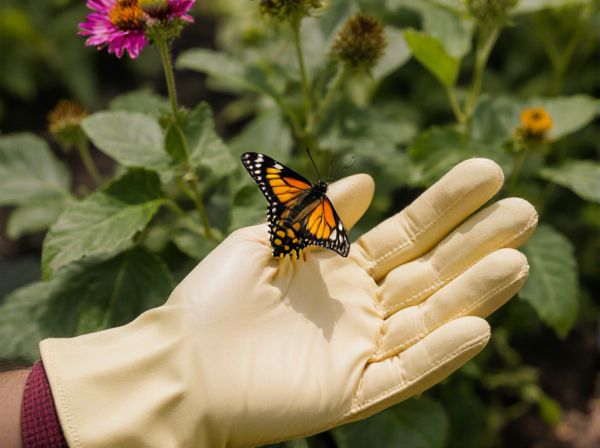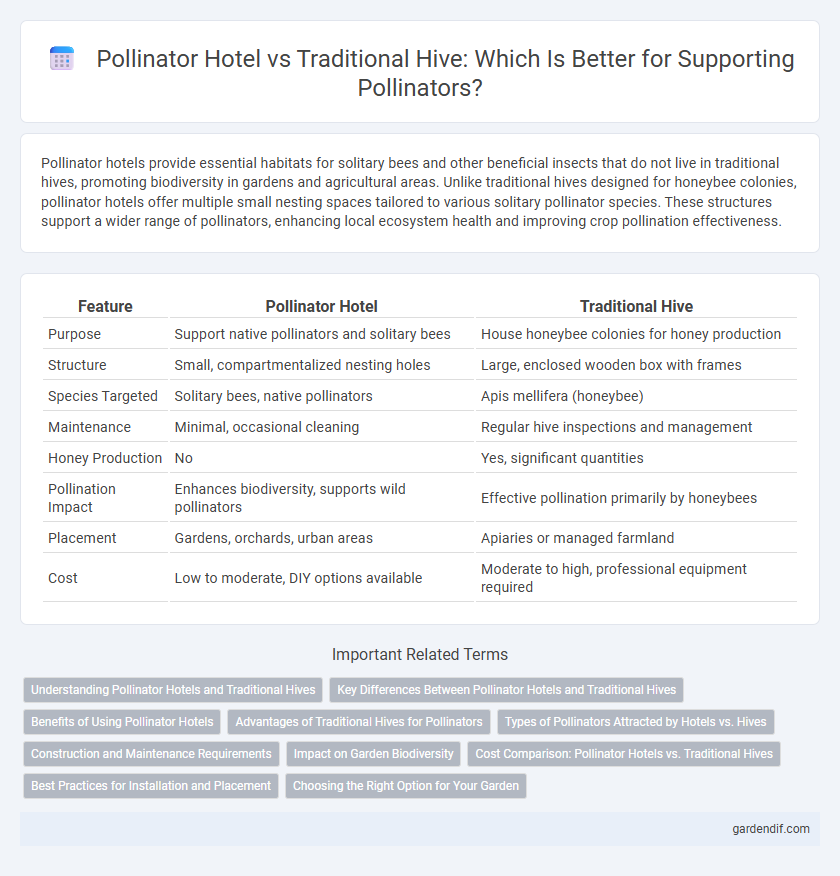
Pollinator hotel vs Traditional hive Illustration
Pollinator hotels provide essential habitats for solitary bees and other beneficial insects that do not live in traditional hives, promoting biodiversity in gardens and agricultural areas. Unlike traditional hives designed for honeybee colonies, pollinator hotels offer multiple small nesting spaces tailored to various solitary pollinator species. These structures support a wider range of pollinators, enhancing local ecosystem health and improving crop pollination effectiveness.
Table of Comparison
| Feature | Pollinator Hotel | Traditional Hive |
|---|---|---|
| Purpose | Support native pollinators and solitary bees | House honeybee colonies for honey production |
| Structure | Small, compartmentalized nesting holes | Large, enclosed wooden box with frames |
| Species Targeted | Solitary bees, native pollinators | Apis mellifera (honeybee) |
| Maintenance | Minimal, occasional cleaning | Regular hive inspections and management |
| Honey Production | No | Yes, significant quantities |
| Pollination Impact | Enhances biodiversity, supports wild pollinators | Effective pollination primarily by honeybees |
| Placement | Gardens, orchards, urban areas | Apiaries or managed farmland |
| Cost | Low to moderate, DIY options available | Moderate to high, professional equipment required |
Understanding Pollinator Hotels and Traditional Hives
Pollinator hotels provide essential shelter for solitary bees and other beneficial insects, offering nesting cavities that mimic natural habitats, which supports biodiversity and enhances pollination efficiency. Traditional hives, designed primarily for social species like honeybees, facilitate large colony management and honey production but do not address the habitat needs of solitary pollinators. Understanding the distinct roles and structures of pollinator hotels versus traditional hives is critical for effective conservation strategies and improving pollination services across ecosystems.
Key Differences Between Pollinator Hotels and Traditional Hives
Pollinator hotels provide targeted nesting habitats primarily for solitary bees and other native pollinators, while traditional hives are designed to house social honeybee colonies. Unlike traditional hives that facilitate honey production and require active management, pollinator hotels focus on biodiversity support with minimal maintenance. The structural design of pollinator hotels features various sized holes and tubes to mimic natural environments, contrasting with the uniform comb structure found in traditional hives.
Benefits of Using Pollinator Hotels
Pollinator hotels enhance biodiversity by providing targeted habitats for solitary bees and beneficial insects, unlike traditional hives that mainly support honeybees. These structures increase pollination efficiency in gardens and agricultural landscapes by attracting a wider range of native pollinators. Pollinator hotels also promote ecosystem health and resilience by supporting species that are crucial for pollination but often overlooked in conventional beekeeping.
Advantages of Traditional Hives for Pollinators
Traditional hives offer a stable and controlled environment with enhanced protection against pests and diseases, crucial for maintaining healthy pollinator populations. The structured design optimizes space for brood rearing and honey storage, promoting colony growth and sustainability. Their accessibility allows for regular monitoring and management, ensuring timely interventions that support pollinator health and productivity.
Types of Pollinators Attracted by Hotels vs. Hives
Pollinator hotels primarily attract solitary bees such as mason bees, leafcutter bees, and other native pollinators, offering diverse nesting habitats like hollow stems and small tunnels. Traditional hives are designed mainly for social species like the European honeybee, which live in large colonies and require complex hive structures for brood rearing. The varied nesting options in pollinator hotels support a wider range of pollinator species, promoting biodiversity beyond the single-species focus of traditional hives.
Construction and Maintenance Requirements
Pollinator hotels typically feature modular compartments made from natural materials like bamboo, wood, and hollow stems, designed to attract solitary bees, requiring minimal assembly and low upkeep compared to traditional hives. Traditional beehives, often constructed from treated wood with movable frames, demand regular inspection, cleaning, and pest management to maintain colony health and productivity. The maintenance of pollinator hotels centers on seasonal cleaning to prevent mold and parasites, whereas traditional hives require more intensive management, including hive inspections, honey harvesting, and disease control.
Impact on Garden Biodiversity
Pollinator hotels provide a diverse range of nesting habitats that support solitary bees and other beneficial insects, enhancing garden biodiversity more effectively than traditional hives. Traditional hives primarily house honeybees, which, while important, do not promote as broad a variety of pollinators. Incorporating pollinator hotels increases species diversity, improving plant pollination and overall ecosystem health in garden environments.
Cost Comparison: Pollinator Hotels vs. Traditional Hives
Pollinator hotels generally cost significantly less than traditional hives, with prices ranging from $20 to $100 compared to $150 to $500 for standard beekeeping setups. Maintenance expenses for pollinator hotels remain minimal due to their simple design and lack of need for extensive equipment or specialized care. Investing in pollinator hotels offers an affordable, low-maintenance alternative to support native pollinators without the higher upfront and operational costs associated with traditional hives.
Best Practices for Installation and Placement
Pollinator hotels should be installed in sunny, sheltered locations away from strong winds and heavy rain to encourage nesting activity, ideally facing southeast to maximize morning sun exposure. Traditional hives require elevated, level ground with good ventilation and protection from direct afternoon sun to maintain optimal temperature and hive health. Both setups benefit from proximity to diverse flowering plants and water sources to support pollinator foraging and colony sustainability.
Choosing the Right Option for Your Garden
Pollinator hotels provide specialized habitats for solitary bees and beneficial insects, enhancing biodiversity and supporting natural pollination in your garden. Traditional hives focus primarily on honeybee colonies, offering productive honey yields but requiring more maintenance and space. Selecting the right option depends on your garden's size, desired pollinator diversity, and maintenance commitment.
Pollinator hotel vs Traditional hive Infographic

 gardendif.com
gardendif.com